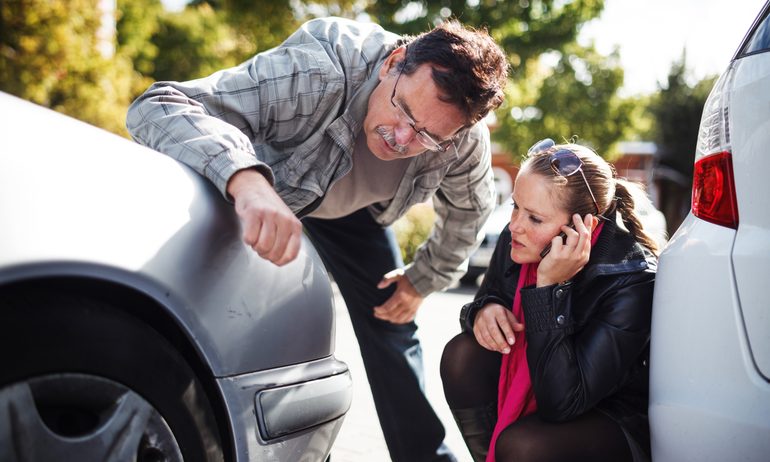Understanding Uninsured Motorist Property Damage Coverage
UMPD covers damage to your car or property after a crash with an at-fault driver who has no car insurance.

Many, or all, of the products featured on this page are from our advertising partners who compensate us when you take certain actions on our website or click to take an action on their website. However, this does not influence our evaluations. Our opinions are our own. Here is a list of our partners and here's how we make money.
The sun is shining, the radio’s blasting and your coffee’s temperature is just right. The day is off to a smooth start — until your car is rear-ended.
In the aftermath, you ask the distracted driver for their insurance information so you can get your car repaired. But what if the driver has none? You may already be covered if your auto policy includes uninsured motorist property damage coverage.

See what you could save on car insurance
Easily compare personalized rates to see how much switching car insurance could save you.About 1 in 8 drivers are uninsured, according to the most recent data from the Insurance Research Council. Many others buy only the minimum limits required by their state, which may not be enough to pay for damage from an accident. If you’re hit by one of these drivers, uninsured motorist property damage coverage could pay your repair expenses.
What is uninsured motorist property damage coverage?
Uninsured motorist property damage coverage, or UMPD, is auto insurance that pays for damage to your car or other property if you’re hit by a driver without car insurance. Similarly, underinsured motorist property damage, or UIMPD, pays out if the at-fault driver in a crash doesn’t have enough insurance to pay for the damage they caused.
Typically, UMPD is combined with uninsured motorist bodily injury coverage, which pays for injuries due to a crash with an at-fault driver who has no car insurance.
What uninsured motorist property damage coverage pays for
UMPD pays for damage to your car or property caused by an uninsured driver, and in some states may also pay out if an underinsured driver causes a crash. Uninsured motorist property damage coverage pays for expenses after a hit-and-run in most states, while others allow a payout only if the driver is identified.
There's a limit for how much UMPD will pay out for a crash, typically the same limit as your property damage liability insurance. Some states require a deductible for UMPD coverage, usually between $200 and $500, which is the amount subtracted from a claim payout.
Here’s how that could work in our rear-ending scenario. Your insurance policy includes $15,000 of uninsured motorist property damage coverage with a $200 deductible; the driver who rear-ended your car caused $5,000 in damage before they drove off. You live in a state where UMPD covers hit-and-run accidents, so your insurer pays $4,800 to repair your car, leaving you to cover the $200 deductible.
Where is UMPD required?
Seven states and Washington, D.C., require drivers to have uninsured motorist property damage coverage on their car insurance.
Maryland requires $15,000 of UMPD, which protects against both uninsured and underinsured drivers, plus hit-and-runs even if the driver isn't identified.
New Hampshire doesn’t require drivers to buy car insurance, but if they do, $25,000 of combined UMPD and UIMPD is required.
North Carolina requires $25,000 of UMPD, and also requires combining it with UIMPD if you purchase more than minimum liability coverage limits.
South Carolina requires $25,000 of UMPD, which covers damage caused only by an uninsured driver. The state requires insurers to offer optional UIMPD.
Vermont requires $10,000 of combined UMPD and UIMPD.
Virginia doesn’t require drivers to buy car insurance, but if they do, $20,000 of combined UMPD and UIMPD is required. If a hit-and-run driver can't be identified, you must pay a $200 deductible.
Washington, D.C., requires $5,000 of UMPD per accident.
West Virginia requires drivers to have $25,000 of UMPD, which covers damage caused only by an uninsured driver. The state requires insurers to offer optional UIMPD.
» MORE: Compare car insurance rates
Twelve other states require insurers to offer UMPD, but drivers are allowed to reject it in writing. They are:
Alaska.
Arkansas.
California.
Delaware.
Georgia.
Indiana.
Louisiana.
Mississippi.
Rhode Island.
Tennessee.
Texas.
Washington.
Illinois and Utah allow drivers to purchase optional UMPD only if they don’t have collision coverage on their policy.

See what you could save on car insurance
Easily compare personalized rates to see how much switching car insurance could save you.UMPD vs. collision: Which should you buy?
As long as uninsured motorist property damage coverage is optional in your state, you can probably skip it if you have collision coverage, as both pay for damage caused by a driver without insurance or without enough coverage.
But there are some differences. Uninsured motorist property damage coverage generally has a lower deductible than collision coverage, and may cover damage to both your vehicle and other property, like your home, from an uninsured driver. Meanwhile, collision coverage covers only damage to your car and pays out regardless of who caused the accident.
If your state allows drivers to have both coverage types, it may be wise to add collision to your policy so you’re not left covering repair costs if the damage exceeds your UMPD limit — the maximum amount your insurer will pay out after a crash. However, if you just want some coverage at the lowest cost, UMPD is generally cheaper, especially if you have a pricey car.

